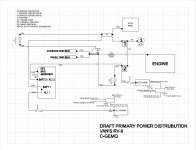claycookiemonster
Well Known Member
I have the 4ga cable from the aft battery coming to the starter through the firewall. From the starter I need to connect additional 4ga cables to each alternator as well as the VPX aft of the firewall.
Seems like a lot of terminals crowding onto the starter lug. There must be a way to connect a bus to that terminal which would have further terminals to handle all the other connections.
I've been searching unsuccessfully.
Seems like a lot of terminals crowding onto the starter lug. There must be a way to connect a bus to that terminal which would have further terminals to handle all the other connections.
I've been searching unsuccessfully.





